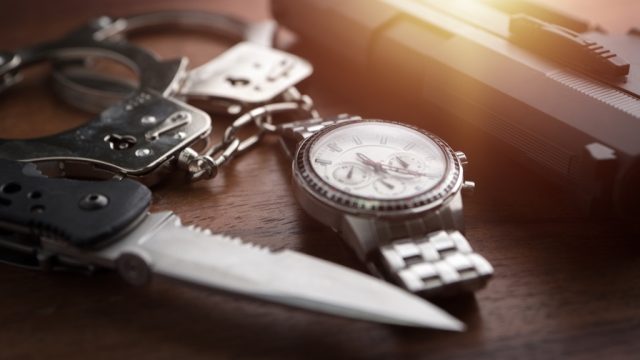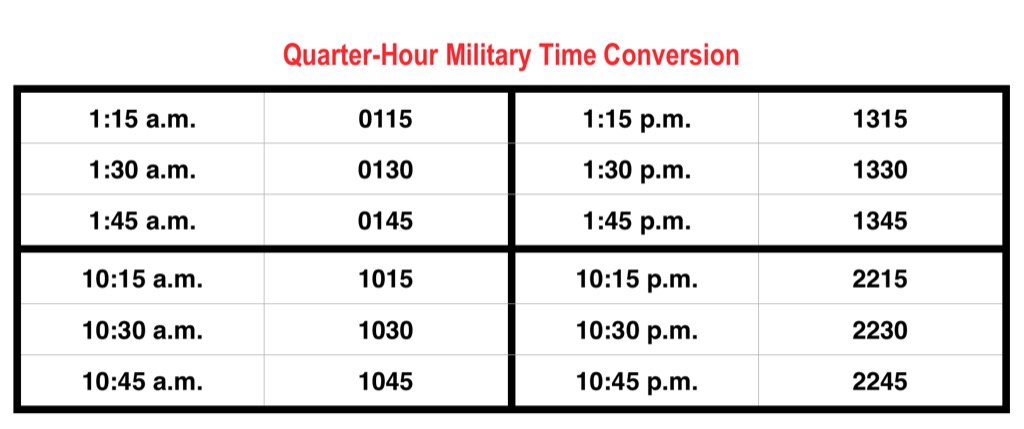Military Time Made Easy: The Best Ways to Use a 24-Hour Clock

As anyone with an enlisted or formerly enlisted friend will attest, military time can be quite a doozy. (“Happy hour at twenty-two hundred zulu!”) And though it may seem strange that your friend is casually dropping military lingo in everyday parlance, here’s the deal: In the grand scheme of things, those of us who use a.m. and p.m. are the backwards ones.
These days, military time—also referred to as the 24-hour clock—is regularly used by pilots, astrologists, meteorologists, transit workers, research scientists, polar explorers and inhabitants, EMTs and hospital employees, and, well, the entirety of our armed forces. Basically, in any profession where the slightest information discrepancy can cause serious error, the 24-hour clock is used. Also, most of the rest of the developed world uses it as a standard chronological measurement. Think of it like the metric system—for clocks.
In other words, yes, you should know how to read it. Here’s how to read military time.
Where the 24-Hour Clock Comes From
To fully understand the 24-hour clock, it helps to bone up on some origins; despite its namesake, the military didn’t actually invent military time. In fact, the practice dates back long before any modern military existed—roughly four millennia, to the Tenth Dynasty of ancient Egypt.
As Otto E. Neugebauer, the famed 20th-century mathematician, notes, in his landmark collection of essays, Astronomy and History, ancient Egyptians coined a system of “decans” to measure time. Units of constellational measurement, a decan refers to one of the various star patterns that would pop up in the night sky on a recurring basis. Egyptians astronomers pinpointed 36, charted their ever-changing positions in the night sky, and drafted tables to keep track of them.
Over time, Egyptian astronomers realized that each newly visible decan marked the start of a 10-solar-lunar cycle, or 10-day, period, leading to a repeating 360-day chart. (If you’re wondering, yes, this system is the foundation of the modern year.) During any given twilight (either dusk or dawn) 18 decans would be visible—but three would overlap with both the previous and forthcoming 10-day cycle, meaning only 12 decans were unique to each cycle. These 12 became the de facto measurement for nighttime hours.
For daytime hours, Egyptians measured time with a device you may recognize: A sundial. These devices broke down the day into 10—the fundamental numeral of human existence—units, with an extra unit for dawn and an extra unit for dusk. The 12 sundial hours plus the 12 decan hours meant each day consisted of 24 hours.
But if the 24-hour clock wasn’t invented by the military, how did it earn the “military time” moniker?
Fast forward 3,900 years, give or take, to the early stages of World War I: In the interest of maintaining strategic consistency and eliminating any mission-thwarting discrepancies—not to mention helping submarine-stationed soldiers tell time—the British Royal Navy adopted the 24-hour clock. Soon after, the rest of the allied forces followed suit and, in the final months of the war, the British Army formally, permanently switched over.
However, it wasn’t until the midst of World War II, that the United States Armed Forces—whose generals had to coordinate fronts in multiple theaters around the globe, and needed specificity to do so effectively—formally adopted the practice, on July 1, 1942, seven months after entering the fight.
How to Read Military Time
The core concept of converting to military time is far from complex; in fact, it boils down to only two simple steps. First, remove the colon and the a.m. or p.m. signifiers. Then, treat the hour as a unit of ten instead of a unit of one (that means placing a zero in front of single-digit numerals). So, 1:00 a.m. would be 0100, 2:00 a.m. would be 0200, and so forth. When it gets to double-digits, things are even easier: You don’t even have to do anything for the second step. 10:00 a.m. becomes 1000, 11:00 a.m. becomes 1100, and on and on.
Noon is where some on-the-fly math comes into play. Starting at a base line of 12, you’ll have to add the p.m. hour and use the resulting number for your military time conversion. Think of the seminal opening line from 1984, by George Orwell: “It was a bright cold day in April and the clocks were striking thirteen.” That’s 1:00 p.m, so 2:00 p.m. becomes 1400—and 11:00 p.m. becomes 2300. And for all of the intervening numbers—don’t worry, we did the math for you—refer to this handy military time chart:

As you’ll see, 12:00 a.m. midnight is referred to as 2400—and this is where things get a little bit complex. Midnight can be referred to as both 2400 and 0000, kind of like an ace in poker can be both a high or a low card. But when you get into minute-by-minute minutiae, the time is always based on the 0000 scale—so 12:01 a.m. is 0001, 12:46 a.m. is 0046, and so on. The following chart, which uses 15-minute increments for four distinct hours (single-digit morning, single-digit evening, double-digit morning, and double-digit evening), should help clear up any outstanding questions about how to translate specific times into corresponding 24-hour clock versions:

How to Say Military Time Out Loud
Reading military time minutes is one thing; saying it is an entirely different beast.
Chances are, you’ve seen some hoorah flick laden with lines like, “Rendezvous at the LZ at oh eight hundred hours.” In some ways, this is correct. But in more ways than one, it’s egregiously false.
For starters, using “oh” in military time is verboten; “zero” is the proper term, full stop. By using zero, a number, instead of “oh,” which could come across as a pause in speech or an exclamation of surprise, there’s absolutely no uncertainty on what the speaker is saying. As such, all five branches of the U.S. military mandate the use of zero. (Another note on zero: If it’s in the midnight hour, zero should be deployed twice.)
To be fair, the use of “hours” isn’t technically incorrect; usage of “hours” varies from service to service, department to department, country to country. But in that sense, when it comes to staying universal, it’s best to simply leave off “hours” altogether.
What the line gets certifiably right, however, is the use of “hundred.” In military time, it’s always “hundred,” never “thousand,” and never ever single, lonesome digits.
So that hypothetical line, “oh eight hundred hours,” would be, simply, “zero eight hundred.”
To elucidate, here’s a sampling of example times with proper pronunciation:
1700: seventeen hundred
2000: twenty hundred
0645: zero six forty-five
1215: twelve fifteen
0015: zero zero fifteen
The Skinny on “Zulu”
Back in 1884, during the International Meridian Conference—an assembly of geopolitical powers-that-be with the aim of determining a longitudinal baseline in an ever more global world—26 nations settled on Greenwich, London, as the baseline, thus creating Greenwich Mean Time (GMT). “Zulu,” a term you may have heard in tandem with military time readings, refers to Coordinated Universal Time (UTC), or “zero hours.” (For all intents and purposes, especially for civilians, the difference between UTC and GMT is nil.)
On international missions, where soldiers may be traversing through multiple time zones, it’s essential to have a chronological standard. UTC is that standard. So if you hear someone say “twenty-two hundred zulu,” that mean it’s 10:00 p.m. at the Greenwich Royal Observatory in London—and 5:00 p.m. (or happy hour o’clock) in New York.
Why Zulu? Simple: In NATO’s phonetic alphabet, Z equals Zulu. And “zero hours” begins with…?
(It’s Z.)
How Professionals Use Military Time
Folks of many non-military walks of life use the 24-hour clock. Pilots use it to stay chronologically grounded. Astrologists use it to measure star charts. Meteorologists use it to accurately keep tabs on storms (though when they present it to you on TV, they’ll kindly convert to a unit you’re used to, as in, “The wind advisory will remain in effect until 10:00 a.m.). Transit workers use it to plot timetables and schedule trains (they also kindly convert it). And research scientists use it to keep studies on-track and globally applicable.
And if you’re a polar inhabitant or explorer—meaning you’re in a locale that has no designated time zone, and may, depending on the season, even have no solar day or night—military time is the only way to tell, for certain, what time it is.
But the perhaps most crucial use of military time is among medical workers: doctors, nurses, EMTs—everyone. Imagine you’re sick, you’re in the ICU, and you need a specific medication at 6:00 p.m. on the dot, daily. The doctor writes that in her medical instructions, and hands them to the nurse. The nurse, unable to clearly read the doctor’s chicken scratch (“Is that an A or a P?” he thinks), administers the drug at the wrong time—by a margin of 12 hours. Obviously, this could prove catastrophic. To avoid even the slightest margin of error, the 24-hour clock is used.
How To Implement Military Time Into Everyday Life
You can easily change the clock on your phone, your tablet, your computer, your social media accounts, and even your microwave to reflect a 24-hour clock. In no time, you’ll grow used to it, and the practice will become second-nature. Just note that, on all of these devices—if you’re using an American-region device, which is likely the case—the time will render with a colon. 1110 will come up as 11:10, no different than what you’ve seen for years; 1300 will come up as 13:00, a bit different than what you’ve seen for years.
And if you’re truly committed, you can even find 24-hour analog watches to sport. (For our money, we’re partial to the Navitimer Cosmonaute by Breitling, a CEO-level timepiece constructed entirely from black steel and adorned with more stylistic bells and whistles than the eye can see. It’s a veritable piece of art.)
How Often You’ll Need to Use Military Time
About as often as you’ll use the metric system.
To discover more amazing secrets about living your best life, click here to follow us on Instagram!